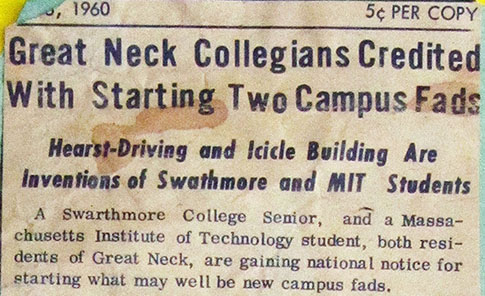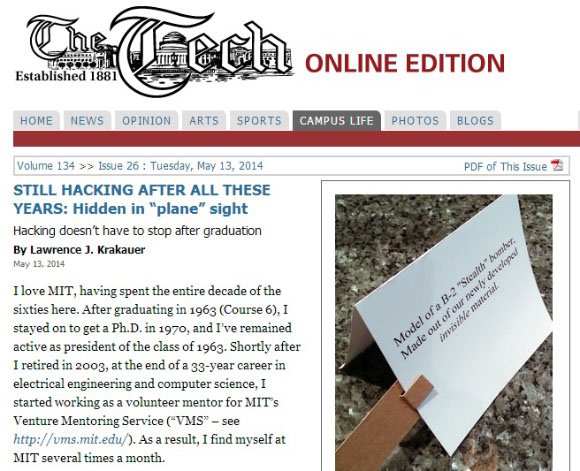
It took me more than 45 years to perpetrate another hack. It was also reported in The Tech, in an article I submitted for the "Campus Life" section of the May 13, 2014 issue, called STILL HACKING AFTER ALL THESE YEARS: Hidden in “plane” sight. I'll get to the more recent hack later, but first, the icicle, which was the subject of a report on the front page of the January 15, 1960 issue of The Tech, under the heading, "Giant Icicle at Baker House Draws National Press Attention". Note 1 It noted that:
The story included some other nonsense which I think Ratner made up just to keep the fad in the news for a while. It said:
Despite the above nonsense, I don't think the icicle Association went anywhere, and in fact I'm not sure it ever actually existed at all. The picture to the left shows the icicle after it had largely melted. You'll note that it appears to start at a random point on the wall, when in fact its origin was at a window, and it was four stories high, not two. MIT initially objected to the icicle, thinking (probably with some justification) that it was hazardous. They told us to knock it down. But when it started getting national publicity, they suddenly changed their tune, and told us to leave it for a while. MIT is always happy to get news coverage that emphasizes how clever their students are. If my memory serves, it was Steve Raphael (always rather a promoter) who made numerous telephone calls to notify the local news outlets. They in turn put the story up on the wire services. Once the story went national, I got a call from a reporter from my hometown newspaper, the Great Neck Record. After he interviewed me, I became part of a story printed in that newspaper, which my mother duly cut out and pasted into a scrapbook. I still have that page of the scrapbook, the article yellowed with age. You can see the article's header below. Note at the top that in 1960, the Great Neck Record apparently cost five cents a copy. I think my parents had a subscription:  The part of the article relating to me reads as follows. Reading it today, I'm rather struck by the enormous number of typographical and other errors in it. There are certain readers of my blog who are eagle-eyed proofreaders - you know who you are. Don't get too excited reading the following text, as I've deliberately preserved all of the typos:
My recollection is that the Great Neck Record picked up the story from one of the wire services, UPI ("United Press International") or AP ("Associated Press"), having noted that one of the participants came from Great Neck. But Margie wonders if my mother, Rose Krakauer, had something to do with notifying the local paper. On reviewing this entry, Margie wrote in the margin, "The original story credited Bob Ratner and Bill Tobin with the icicle, but the Great Neck Record seemed to think that you were the star of the story. That sounds like Rose." As I noted above, it took me over 45 years to perpetrate another MIT hack, which involved inserting a humorous sign into an empty display case on campus. I reported on it in my blog entry MIT scenes, which I recently adapted into an article for the Campus Life section of The Tech. Below, the top part of the online version of the article - click on it if you want to see the whole thing on the The Tech site.   Note 1: Click the next link if you want to see the front page of the 1/15/60 edition of The Tech in PDF form. [return to text] Note 2: The errors, including errors in the entire article, not just the sentences I quoted: One sentence has an extraneous "the". The final sentence has an "are" which should be an "is". The article misspells "laugh" as "laught", "too" as "to", "use" as "sue", "for" as "fo", "an" as "and", and "giant" as "fiant". Then I recalled that in 1960 there was no computerized typesetting, and no automated spellcheckers. A spelling checker would have fixed "laught", "fo", and "fiant", although it wouldn't have done anything about "to", "sue", and "and". I imagine the paper was typeset on a Linotype machine, which casts an entire line of type in lead. That would account for the line "seldom abused by its drver," being followed in the article by the corrected line "seldom abused by its driver, and". Errors of that sort used to sneak into newspapers when a Linotype operator generated a corrected line, but neglected to remove the incorrect line it was supposed to replace. [return to text]  |
 As I noted in a
As I noted in a 